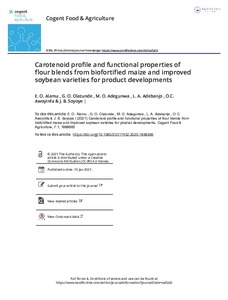| dc.contributor.author | Alamu, E.O. |
| dc.contributor.author | Olatunde, G.O. |
| dc.contributor.author | Adegunwa, M.O. |
| dc.contributor.author | Adebanjo, L.A. |
| dc.contributor.author | Awoyinfa, O.C. |
| dc.contributor.author | Soyoye, J.B. |
| dc.date.accessioned | 2021-02-17T14:04:45Z |
| dc.date.available | 2021-02-17T14:04:45Z |
| dc.date.issued | 2021 |
| dc.identifier.citation | Alamu, E.O., Olatunde, G.O., Adegunwa, M.O., Adebanjo, L.A., Awoyinfa, O.C. & Soyoye, J.B. (2021). Carotenoid profile and functional properties of flour blends from biofortified maize and improved soybean varieties for product developments. Cogent Food & Agriculture, 7(1), 1868665: 1-16. |
| dc.identifier.issn | 2331-1932 |
| dc.identifier.uri | https://hdl.handle.net/20.500.12478/7048 |
| dc.description.abstract | Biofortified maize has received increased attention from a nutraceutical perspective because of its bioactive phytochemical components, including carotenoids. However, biofortified maize is limiting in some amino acids which are present in soybeans; hence both crops are used as blends in food products. Thus, this study aimed to evaluate the carotenoids and functional properties of maize-soybean flour blends as influenced by biofortified maize variety. Flour blends were prepared from each maize flour by substituting with 0–30% soybean flour. The flour samples were analysed for the carotenoid profile, proximate composition, colour, functional and pasting profile using standard methods. Carotenoids varied between the biofortified maize flours with xanthophylls (10.93–12.61 µg/g) being the most abundant, especially zeaxanthin (6.31–6.75 µg/g). Biofortified maize-soybean flour blends had lower carotenoid profiles with lower pro-vitamin A (3.79–6.99 µg/g) and xanthophylls (2.94–10.59 µg/g). The blends had higher protein, fat and ash contents with lower crude fibre and total carbohydrate than 100% biofortified maize flours. The blends also had lower bulk density, dispersibility, swelling power and pasting viscosities but increased solubility for both maize varieties. Maize flour from Sammaz 39 variety had higher pasting viscosities than Sammaz 40 variety. Trough, setback and final viscosities of maize-soybean flour blends made with S39 maize variety indicate pasting properties that will produce desirable properties in food products. The results showed that the blends could provide the raw material for the production of food products with improved carotenoid and protein contents as well as desirable functional qualities. |
| dc.format.extent | 1-16 |
| dc.language.iso | en |
| dc.subject | Biofortification |
| dc.subject | Maize |
| dc.subject | Soybeans |
| dc.subject | Flours |
| dc.subject | Carotenoids |
| dc.subject | Micronutrients |
| dc.title | Carotenoid profile and functional properties of flour blends from biofortified maize and improved soybean varieties for product developments |
| dc.type | Journal Article |
| cg.contributor.crp | Agriculture for Nutrition and Health |
| cg.contributor.affiliation | International Institute of Tropical Agriculture |
| cg.contributor.affiliation | Federal University of Agriculture, Abeokuta |
| cg.coverage.region | Africa |
| cg.coverage.region | West Africa |
| cg.coverage.country | Nigeria |
| cg.coverage.hub | Southern Africa Hub |
| cg.researchtheme | Nutrition and Human Health |
| cg.identifier.bibtexciteid | ALAMU:2021 |
| cg.isijournal | ISI Journal |
| cg.authorship.types | CGIAR and developing country institute |
| cg.iitasubject | Agronomy |
| cg.iitasubject | Biofortification |
| cg.iitasubject | Food Security |
| cg.iitasubject | Maize |
| cg.iitasubject | Nutrition |
| cg.iitasubject | Plant Breeding |
| cg.iitasubject | Plant Production |
| cg.iitasubject | Soybean |
| cg.journal | Cogent Food & Agriculture |
| cg.notes | Open Access Journal; Published online: 13 Jan 2021 |
| cg.accessibilitystatus | Open Access |
| cg.reviewstatus | Peer Review |
| cg.usagerightslicense | Creative Commons Attribution 4.0 (CC BY 0.0) |
| cg.targetaudience | Scientists |
| cg.identifier.doi | http://dx.doi.org/10.1080/23311932.2020.1868665 |
| cg.iitaauthor.identifier | Alamu Emmanuel Oladeji: 0000-0001-6263-1359 |
| cg.futureupdate.required | No |

